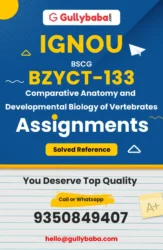IGNOU BZYET-143 Insect Vectors and Vector Borne Diseases - Latest Solved Assignment
Get IGNOU BZYET-143 Assignments Soft Copy ready for Download in PDF for (January 2024 – December 2024) in English and Hindi Language.
- Helps save time and effort-really well
- Promises Good Marks in Less Time
- Answers that are verified and accurate
- Based on IGNOU Guidelines.
- Description
- Previous Year Solved Question Papers Included
- Assignments Details
- Assignment Submission End Date
- What's Included
PLEASE MATCH YOUR ASSIGNMENT QUESTIONS ACCORDING TO YOUR SESSION
IGNOU BZYET-143 (January 2024 – December 2024) Assignment Questions
1. i) Give two examples of insects for each of the following types of metamorphosis:
a) No metamorphosis: ………………………………………
b) Incomplete metamorphosis: ……………………………..
c) Complete metamorphosis: ……………………………….
ii) Give the different developmental stages in the following insects:
a) Silver fish: ………………………………………………..
b) Grass hopper: ……………………………………………
2. a) Differentiate between:
i) Propagative Transmission and Cyclopropagative Transmission
ii) Cyclodevelopmental Transmission and Vertical Transmission
b) Answer the following questions:
i) Name the reduced hindwings of diptera and write their functions.
ii) How do mosquitoes detect their host for sucking of blood?
3. a) Name a hemimetabolous order which is exclusively parasitic. Explain its morphological features in brief.
b) Write the important features of Order Siphonaptera which make them important disease vectors.
4. Write short notes on the following:
a) Prevention /control measures of fleas.
b) Typhus fever
c) Tunga penetrans
d) Yersinia pestis transmission
5. a) Distinguish between the following:
i) Pediculus humanus corporis and Pediculus humanus capitis
ii) Male and Female body louse
b) Explain the role of Reduviid bug as a biological vector in the transmission of Chagas disease.
6. a) Explain the epidemiology of malarial parasite.
b) Discuss the preventive and control measures of Anopheles mosquito.
7. Draw a labeled diagram of:
a) Life cycle of JE
b) Filarial worm transmission Cycle
8. Give difference between the following:
a) Extrinsic incubation period and intrinsic incubation period
b) Transverse and vertical transmission
c) Urban cycle and sylvatic cycle
9. Write short notes on:
a) Traps used for controlling houseflies
b) Cultural control of Musca
c) Chemical control of housefly
d) Myiasis
10. a) Explain the concept of Integrated Vector Management.
b) How can the disease vectors be genetically manipulated to reduce their population?
IGNOU BZYET-143 (January 2023 – December 2023) Assignment Questions
Part-A
1. Which structural, developmental and behavioristic characteristics make insects highly successful organisms on Earth?
2. Write short notes on following:
i) Mouthpart modifications in insects
ii) Types of antennae in insects
iii) Typical structure of insect wing
iv) Leg modifications in insects
3. i) Read the following sentences and tick mark the correct alternative.
a) Incubating/Convalescent carriers are infected and can spread the pathogen, but do not show the symptoms of illness.
b) The only function of mechanical/biological vectors is to transport the infectious agents which don’t really need vectors to complete their life cycle.
c) In propagative/cyclopropagative transmission the pathogen undergoes a developmental cycle and multiplication in the body of arthropod.
d) Some virus and rickettsiae are transmitted from male/female parent through the sperms/eggs to the offspring.
ii) Differentiate between:
a) Propagative Transmission and Cyclopropagative Transmission
b) Cyclodevelopmental Transmission and Vertical Transmission
4. i) Name four insect orders which are of medical importance. Write at least one conspicuous feature and three examples of each order.
ii) Give reasons for the following features found in insects.
a) Fleas have a laterally compressed body.
b) Forewings of a few hemipterans are called hemelytra.
c) Hind legs of fleas are saltatorial types with large coxae.
d) Saliva of haematophagous insects contain anticoagulant.
e) Heteroptera have a characteristic scutellum which is absent in homopterans.
f) The under surface of the housefly labella has prestomial teeth.
5. i) Explain the role of Reduviid bug as a biological vector in the transmission of Chagas disease.
ii) What preventive measures will you take for controlling the bed bugs from entering your house?
Part-B
6. i) Read the following sentences and write True (T) or False (F).
a) Malaria is a disease caused by Anopheles mosquito.
b) The vector for malaria is Culex species.
c) The infection of malaria starts when a female mosquito injects sporozoites of Plasmodium sp. present in her saliva into a human skin.
d) Plasmodium cannot complete its life cycle at temperature below 20C.
e) During pregnancy malaria can lead to premature baby delivery.
f) Most malarial deaths occur in urban areas.
ii) Discuss the preventive and control measures of Anopheles mosquito.
7. i) Write a short note on dengue prevention and control.
ii) Draw a labeled diagram of:
a) Life cycle of Aedes mosquito.
b) Dengue transmission Cycle.
c) Zika Transmission Cycle.
8. Write short notes on:
a) Traps used for controlling houseflies
b) Cultural control of Musca
c) Chemical control of housefly
d) Myiasis
9. i) Write the ecological factors favourable for the transmission of Kalaazar.
ii) Illustrate the transmission of visceral leishmaniasis in human beings.
10. i) Explain the concept of Integrated Vector Management.
ii) Why have insects vectors developed resistance to insecticides?
IGNOU BZYET-143 (January 2024 – December 2024) Assignment Questions
1. i) निम्नलिखित किस्मों के कायांतरणों में से प्रत्येक के कीटों के दो उदाहरण दीजिए:
क) सिल्वर फिश ……………………………………………..
ख) टिड्डा ……………………………………………..
ग) तितली ……………………………………………..
ii) निम्नलिखित कीटों की विभिन्न परिवर्धनात्मक अवस्थाएँ लिखिए:
क) सिल्वर फ़िश ……………………………………………..
ख) टिड्डा ……………………………………………..
2. क) निम्नलिखित के बीच अंतर लिखिए:
i) प्रवर्धी संचरण और चक्रवर्धी संचरण
ii) चक्र – विकासमूलक संचरण और लंबवत् ऊर्ध्वाधर संचरण
ख) निम्नलिखित प्रश्नों के उत्तर दीजिए:
i) डिप्टेरा के लघुकृत पिछले पंखो का नाम बतायें और उनके कार्यों को लिखें।
ii) रक्त चूसने के लिए मच्छर अपने परपोषी का पता कैसे लगाते हैं?3.
3. क) एक हेमीमेटाबोलस ऑर्डर का नाम बताइए जो विशेष रूप से परजीवी है। संक्षेप में इसकी आकारिकीय विशेषताओं की व्याख्या कीजिए ।
ख) ऑर्डर साइफनाप्टेरा की महत्त्वपूर्ण विशेषताओं को लिखें जो उन्हें महत्त्वपूर्ण रोग वेक्टर बनाते हैं।
4. निम्नलिखित पर लघु टिप्पणी कीजिए :
i) पिस्सुओं की रोकथाम और नियंत्रण के उपाय
ii) टाइफस ज्वर
iii) टुंगा पेनीट्रेन्स
iv) मेर्सीनिया पेस्टिस संचरण
5. क) निम्नलिखित के बीच अंतर कीजिए:
i) पेडीकुलस हयूमेनस केर्पोरिस और पेडीकुलस हयूमेनस कैपीटिस
ii) नर और मादा देह जूंएं
ख) चगास रोग के संचरण में एक जैविक संवाहक (वेक्टर) के रूप में रेडुविड बग की भूमिका की व्याख्या करें।
6. क) मलेरिया परजीवी की महामारी विज्ञान की व्याख्या करें।
ख) ऐनोफेलीज़ मच्छर से बचाव और नियंत्रण के उपायों की चर्चा कीजिए ।
7. निम्नलिखित का नामांकित चित्र बनाइए
क) JE का जीवन चक्र
ख) फाइलेरिया कृमि संचरण चक्र
8. निम्नलिखित में अंतर लिखिए:
क) बाहरी ऊष्मायन अवधि और आंतरिक ऊष्मायन अवधि
ख) अनुप्रस्थ और ऊर्ध्वाधर संचरण
ग) शहरी चक्र और सिल्वेटिक चक्र
9. निम्नलिखित पर संक्षिप्त टिप्पणियाँ लिखिए:
क) घरेलू मक्खियों के नियंत्रण में प्रयुक्त ट्रैप (पाश)
(ख) मस्का का सस्य नियंत्रण
ग) घरेलू मक्खी का रासायनिक नियंत्रण
घ) माएसिस
10. क) एकीकृत वेक्टर प्रबंधन की अवधारणा का वर्णन कीजिए।
ख) रोग वेक्टर समष्टि को कम करने हेतु आनुवंशिक परिवर्तन कैसे किये जा सकते हैं?
IGNOU BZYET-143 (January 2023 – December 2023) Assignment Questions
भाग-क
1. कौन सी संरचनात्मक विकासात्मक और व्यवहारिक विशेषताएं कीटों को पृथ्वी पर अत्यधिक सफल जीव बनाती हैं? वर्णन कीजिए।
2. निम्नलिखित पर संक्षिप्त नोट लिखिए:
i) कीटों के मुखांगों में रूपांतरण
ii) कीटों में ऐन्टेना के प्रकार
iii) कीट पंख की प्ररूपीय संरचना
iv) कीटों के पादों में रूपांतरण
3. i) निम्नलिखित वाक्यों को पढ़िए और सही विकल्प पर सही का निशान लगाइए।
क) उष्माति / अपशक वाहक (incubating / Convalescent carriers ) सवंमित होते हैं और रोगजनक को फैला सकते हैं, लेकिन बीमारी के स्पष्ट लक्षण नहीं दर्शाते।
ख) यांत्रिक/ जैविक वेक्टर का एकमात्र कार्य संक्रामक एजेंटों को एक स्थान से दूसरे स्थान पर ले जाता है, जिन्हें वास्तव में अपने जीवन चक्र को पूरा करने के लिए वेक्टर की आवश्यकता नहीं होती है।
ग) प्रवर्धी / चक्रवर्धी संचरण (propagative / cyclopropagative transmission) में वेक्टर आर्थ्रोपोड के शरीर में एक विकास चक्र से गुजरता है और अपनी संख्या में वृद्धि करता है।
घ) कुछ विषाणु और रिकेट्सिया नर / मादा माता-पिता से शुक्राणुओं / अंडों के माध्यम से संतति में संचरित होते हैं।
ii) निम्नलिखित के बीच अंतर लिखिए:
क) प्रवर्धी संचरण और चक्रवर्धी संचरण
ख) चक्र-विकासमूलक संचरण और लंबवत् ऊर्ध्वाधर संचरण
4. i) चार कीट ऑर्डरों के नाम बताइए जो चिकित्सकीय रूप से महत्त्वपूर्ण हैं। प्रत्येक ऑर्डर की कम से कम एक विशिष्ट विशेषता बताइए और तीन उदाहरण लिखें ।
ii) कीटों में पाई जाने वाली निम्नलिखित विशेषताओं के कारण बताइए
क) पिस्सू में पार्श्व रूप से संकुचित शरीर होता है।
ख) कुछ हेमिप्टेरानों के अग्रिम पंखों को हेमेलाइट्रा कहा जाता है।
ग) पिस्सू के पिछले पादों में बड़े कॉक्से होते है और वे वल्गी प्रकार के होते हैं।
घ)रक्तभक्षी कीटों की लार में प्रतिस्कंदन होता है।
ङ) हिटरोपटेरा में एक विशिष्ट स्कुटेल्लम होता है जबकि होमोप्टेरा में यह अनुपस्थित होता है।
च) घरेलू मक्खी लैबला के नीचे की सतह में प्रीस्टोमियल दांत होते हैं।
5. i) चगास रोग के संचरण में एक जैविक संवाहक (वेक्टर) के रूप में रेडुविड बग की भूमिका की व्याख्या करें।
ii) खटमल के घर में प्रवेश को नियंत्रित करने के लिय आप क्या निवारक उपाय करेंगे?
भाग – ख
6. i) निम्नलिखित वाक्यों को पढ़िए और सही (T) या गलत (F) लिखिए ।
क) मलेरिया ऐनोफेलीज़ मच्छर से होने वाली बीमारी है।
ख) मलेरिया का वेक्टर क्यूलेक्स प्रजाति है ।
ग) मलेरिया का संक्रमण तब शुरू होता है जब मादा मच्छर प्लैज्मोडियम प्रजाति के स्पोरोजोइट्स जो उसके लार मे उपस्थित होते हैं, को मानव त्वचा में इंजेक्ट करती है।
घ) प्लैज्मोडियम 20°C से कम तापमान पर अपना जीवन चक्र पूरा नहीं कर सकता है।
ङ) गर्भावस्था के दौरान मलेरिया के कारण समय से पहले बच्चे का जन्म हो सकता है।
च) अधिकांश मलेरिया से होने वाली मौतें शहरी क्षेत्रों में होती हैं।
ii) ऐनोफेलीज़ मच्छर से बचाव और नियंत्रण के उपायों की चर्चा कीजिए ।
7. i) डेंगू की रोकथाम और नियंत्रण पर एक संक्षिप्त टिप्पणी लिखिए ।
ii) निम्नलिखित के नामांकित चित्र बनाइए
क) एडीज मच्छर का जीवन चक्र ।
ख) डेंगू संचरण चक्र |
ग) जीका संचरण चक्र ।
8. निम्नलिखित पर संक्षिप्त टिप्पणियाँ लिखिए:
क) घरेलू मक्खियों के नियंत्रण में प्रयुक्त ट्रैप (पाश) ।
ख) मस्का का सस्य नियंत्रण |
ग) घरेलू मक्खी का रासायनिक नियंत्रण ।
घ) माएसिस ।
9. i) काला आज़ार रोग के संचरण में सहायक वातावरणीय कारकों का वर्णन कीजिए ।
ii) मानव में विसरल लिशमानीएसिस के संचरण को चित्र द्वारा समझाइए ।
10. i) एकीकृत वेक्टर प्रबंधन की अवधारणा की वर्णन कीजिए ।
ii) रोग वेक्टर समष्टि को कम करने हेतु आनुवंशिक परिवर्तन कैसे किये जा सकते हैं?
BZYET-143 Assignments Details
| University | : | IGNOU (Indira Gandhi National Open University) |
| Title | : | Insect Vectors and Vector Borne Diseases |
| Language(s) | : | English, Hindi |
| Code | : | BZYET-143 |
| Degree | : | |
| Subject | : | Zoology |
| Course | : | Discipline Specific Electives (DSE) |
| Author | : | Gullybaba.com Panel |
| Publisher | : | Gullybaba Publishing House Pvt. Ltd. |









